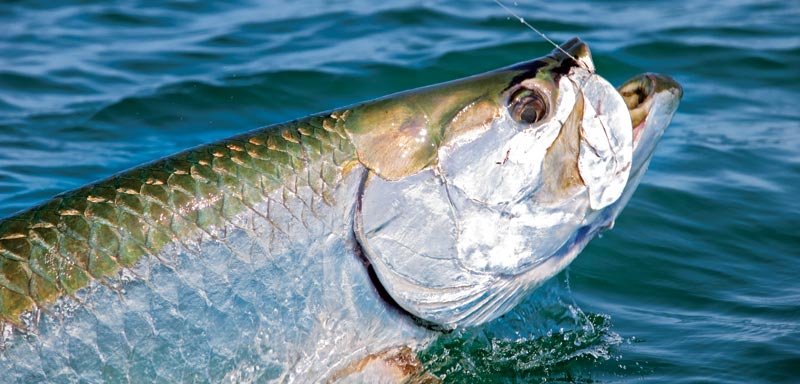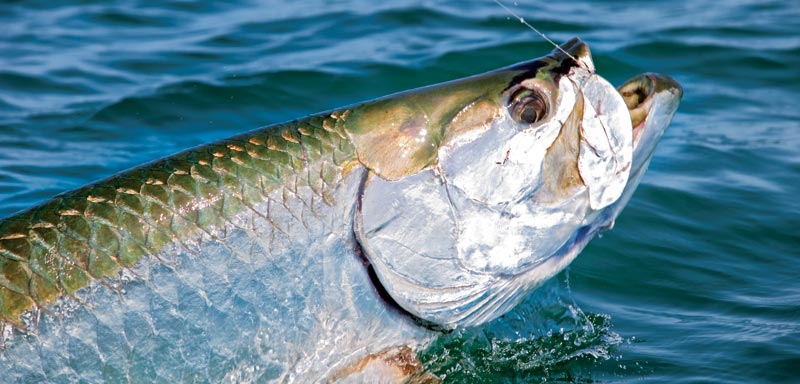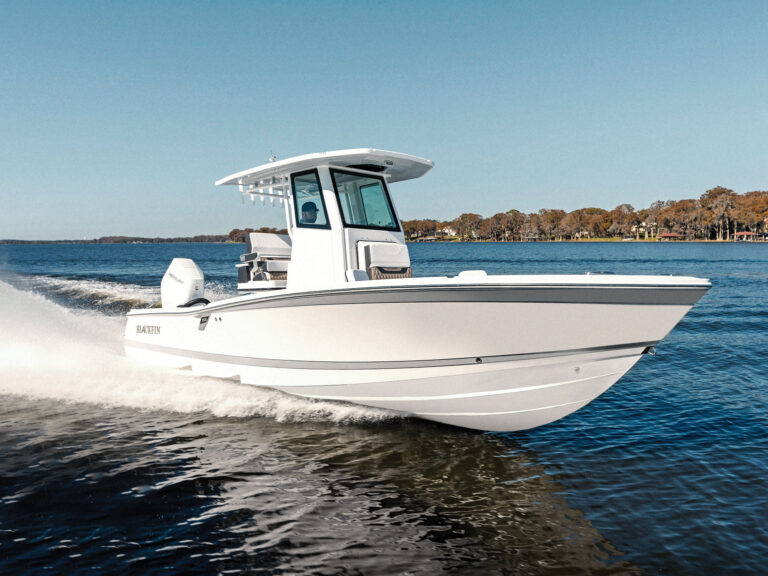
Low Country Tarpon
Like a Polaris rocket, the shimmering silver-and-green fish shot straight into the air before crashing back to the surface with a loud splash. The strike happened so fast that even the 10/0 circle hook failed to hold. Still, the brief appearance of the 150-pound tarpon confirmed we were in the zone, and conditions were ripe to hook another.
The “zone” was South Carolina’s Port Royal Sound, near Bay Point, on the last of the incoming tide. Long known as a cobia hot spot, this expansive Low Country waterway also collects big tarpon from midsummer until fall. Capt. Mike Perry, the resident guide for nearby Spring Island, hosted my initiation last September.
“By the Fourth of July we’ll start to see pods of fish rolling in depths of 25 to 40 feet,” Perry explains. “They’ll really stack up through the rest of the summer but bolt by the first cold snap. Low Country tarpon average 80 to 100 pounds, and we’ll normally get up to a half-dozen shots daily. Six for six was my personal best, and it’s not unusual to catch one up to 130 pounds.”
Fed by the Broad River and a maze of tidal creeks and salt marsh, Port Royal Sound offers ideal tarpon habitat. Shrimp and baitfish flush out of the system with the strong tidal currents, and there are plenty of ledges and holes along the bottom. As the bait is pushed toward the surface by upwellings, hungry tarpon follow to feed.
Although jigs, plugs or flies are popular in other areas, Perry and most South Carolina tarpon chasers serve up a steady diet of meat, with chum as an appetizer. Hand-size menhaden or pogies are the main course. Perry scans the surface for slicks, flipping fish and diving pelicans before he shuts down the outboards and drifts into cast-net range. If he’s lucky, the menhaden will be concentrated in big pods off Hilton Head Island bayside and it will take only a few throws of the 12-foot net to load up. After the livewell is filled to capacity, the rest of the fish are dumped into a 94-quart cooler filled partially with ice and seawater. The brine firms the flesh and makes it easier to grind. Chilled chum also packs tighter in a chum bag.
After anchoring in position, Perry sets a four-rod spread. Two spinning rods with live pogies are deployed on the surface. A clacker-style float acts as a strike indicator. The second set of baits are sent staggered to the bottom on conventional outfits. Depending on the current, teardrop sinkers up to 8 ounces are tied to a fish-finder rig. Perry also uses a 60-foot section of 50-pound fluorocarbon as a top shot over the 100-pound braided main line so the braid doesn’t hum in strong current. Perry changes the fluorocarbon leader every day. He’s convinced abrasion from the sand turns the leader hazy, making it easier for the tarpon to spot.
“Pogy bombs,” or three baits impaled on big circle hooks through the eye sockets, are typically deployed on the bottom, although “double deadies” are also common. Perry occasionally sandwiches a live bait between two dead ones, “to give them a heartbeat,” he explains. With all circle hooks, he impales a short piece of surgical rubber tubing on the hook point. This prevents the hooks from turning into the bait. He checks or changes dead baits every 30 minutes; strikes determine adjustment. If he gets several on the dead baits, Perry will switch all the rods over to the same setup. But if the sharks get too bad, he’ll go with strictly live baits. A variety of sharks, bull redfish and jack crevalle is common bycatch in Port Royal Sound.
Once the baits are out, the chumming begins. Perry uses an electric grinder to pulverize the chilled menhaden, which he loads into a mesh bag that’s tied off the side. The drifting oil and particles draw fish into the spread. Along with the bag, Perry chums regularly with pogies cut in half. “I like to keep a steady supply going,” he says. “Once one piece sinks, I’ll add another.”
For the most part, these tarpon are predictable. “They have preferred spots depending on the tide,” Perry says. “They like an incoming tide best, but I’ve got a few places that are good on the outgoing as well. They bite best on the last quarter up until slack.”
Depending on conditions, fish will haunt the mouth of the sound (the Sticks or Joiner Bank) all the way up to the Broad River Bridge or the old railroad trestle near Hall Island. The bait and tarpon generally hold in the shadows in the middle of the day. Bay Point, where we anchored, is another prime spot.
It wasn’t long after the 150-pounder eluded the hook before we had another solid strike on one of the bottom rods. This time the hook bit, and our designated angler, Mike Reid, was quickly tight to his first-ever tarpon. After about 15 minutes of seesaw action, the 75-pounder strained on the surface. With one last effort, however, it lunged and was gone as Perry leadered it boat-side. It was a legal release, but Reid missed his photo opportunity. We put out another round of fresh baits.
A short time later, one of the bottom rods bowed nearly double, and this time Reid truly had a fight on his hands. With a series of gill-rattling leaps and showering spray, the 130-pounder fought for every inch of line. Finally, after 20 minutes of sweat and strain, Reid had his prize close enough for Perry to reach the leader. As Perry was about to grab the jaws, the worn leader parted, and the fish was gone.
“Wow, what a magnificent animal,” an exhausted Reid said afterward. “They have so much power. I can’t wait to do that again.” In South Carolina’s Port Royal Sound, he certainly has plenty of opportunities.
Carolina Low Country
Rods: Heavy-action 7-foot spinning rods for surface baits. Heavy-action 8-foot conventional rods for bottom outfits.
Reels: 6000-series spinning reels with smooth drags and large-capacity spools, along with two-speed casting reels in the 30-pound class.
Lines: Load spinning reels with 65-pound braided line; on conven-tionals, load up 100-pound braid with 60 feet of 50-pound fluorocarbon top shot. The fluoro top shot doesn’t hum in the current like braid.
_
Terminal tackle:_ Hooks vary from 7/0 welded-eye live-bait styles to 10/0 circles connected to 80-pound fluorocarbon leaders. Loop knots are preferred for the live-bait setup, while bottom-rig leaders should be snelled to the hook shank. To hold bottom in strong current, teardrop sinkers up to 8 ounces are connected with a fish-finder rig. All terminal connections are made using improved clinch knots.
Baits: Live or fresh-dead menhaden.
Spring Island is a private retirement and second-home community nestled in the heart of the Low Country marsh. With much of the island set aside as a nature preserve, it is an ideal retreat for sport-fishing enthusiasts. There are tarpon and cobia in the sound, and the surrounding tidal creeks are loaded with game fish. Salt ponds, fed tidally through rice gates, provide wade-fishing opportunities for tailing redfish, drum, flounder and trout. Spring Island also has its own boat ramp, docks and dry storage. For more information on how to arrange a visit, call 866-740-0400 or check out www.springisland.com.













